Enhancing Maritime Safety and Efficiency: A Comprehensive Sea Fog Monitoring System for Ningbo Zhoushan Port
Abstract
:1. Introduction
2. Materials and Methods
2.1. Data
2.2. Data Processing
2.2.1. Automatic Detection of Sea Fog
2.2.2. Data Quality Control
- Abnormal Humidity Detection: If the humidity level at a particular station exceeds 95% while the humidity at neighboring stations remains below 80%, we identify the humidity value as abnormal.
- Pending Humidity Assessment: If the surrounding humidity exceeds 90%, and the visibility recorded by nearby front scatter sensors remains above 10,000, we label the humidity value as “pending” and proceed with further actions. If the visibility remains unchanged after 10 min, we classify the humidity value as an outlier.
- Visibility Monitoring: In cases where visibility decreases rapidly over a specific period, and the humidity values at nearby stations do not indicate high humidity conditions, we deem the visibility abnormal and implement maintenance measures.
- Laser Visibility Radar Assessment: When the range covered by several consecutive scanning beams remains within 4000 m, and the surrounding humidity values do not suggest high humidity conditions, we conclude that the laser visibility radar is faulty. If some data within the scanning range indicates visibility within 4000 m, we refer to forward scatter visibility values and humidity readings in the nearby area for further assessment.
3. Results
3.1. Heavy Fog on 3–4 May 2023
3.2. Heavy Fog on 31 March–2 April 2021
4. Discussion
4.1. Service Standards
4.2. Monitoring and Situation Warnings
4.2.1. Heavy Fog 3–4 May 2023
4.2.2. Heavy Fog 31 March–2 April 2021
5. Conclusions
Author Contributions
Funding
Institutional Review Board Statement
Informed Consent Statement
Data Availability Statement
Acknowledgments
Conflicts of Interest
References
- WMO. International Meteorological Vocabulary; World Meteorological Organization: Geneva, Switzerland, 1992; 784p, ISBN 978-92-63-02182-3. [Google Scholar]
- Shao, N.; Lu, C.; Jia, X.; Wang, Y.; Li, Y.; Yin, Y.; Zhu, B.; Zhao, T.; Liu, D.; Niu, S.; et al. Radiation fog properties in two consecutive events under polluted and clean conditions in the Yangtze River Delta, China: A simulation study. Atmos. Chem. Phys. 2023, 23, 9873–9890. [Google Scholar] [CrossRef]
- Fitzjarrald, D.R.; Lala, G.G. Hudson Valley Fog Environments. J. Appl. Meteorol. Clim. 1989, 28, 1303–1328. [Google Scholar] [CrossRef]
- Yan, S.; Deng, B.; Yin, J.; Fan, L. Statistical forecast of advective fog in spring over east Zhejiang sea area. Mar. Forecast 2007, 24, 49–54. [Google Scholar]
- Cao, Z.; Liu, F.; He, Q.; Ma, E.; Li, F.; Li, B. Analysis of a continuous sea fog process along the coast of Zhejiang in the spring of 2018. Mar. Forecast 2022, 39, 74–82. [Google Scholar]
- Kutty, S.; Agnihotri, G.; Dimri, A.; Gultepe, I. Fog occurrence and associated meteorological factors over Kempegowda International Airport, India. Pure Appl. Geophy. 2019, 176, 2179–2190. [Google Scholar] [CrossRef]
- Shi, X.; Sun, B.; Liu, X.; Liu, S. Observation and diagnostic analysis of sea fog process in Qingdao offshore. Trans. Oceanol. Limnol. 2023, 45, 1–6. [Google Scholar] [CrossRef]
- Taylor, G.I. The formation of fog and mist. Quart. J. Roy. Meteor. Soc. 1917, 43, 241–268. [Google Scholar] [CrossRef]
- Croft, J.; Pfost, L.; Medlin, M.; Johnson, A. Fog forecasting for the southern region: A conceptual model approach. Weather Forecast 1997, 12, 545–556. [Google Scholar] [CrossRef]
- Cho, K.; Kim, O.; Kim, C. Sea fog around the Korean Peninsula. J. Appl. Meteorol. Climatol. 2000, 39, 2473–2479. [Google Scholar] [CrossRef]
- Hu, L.; Feng, K.; Yang, H.; Fu, W. Application of millimeter wave radar in sea fog monitoring in Beilun port area. Meteorol. Sci. Technol. 2020, 48, 171–177. [Google Scholar]
- Hou, W.; Wang, J. Analyze Zhejiang inshore fog’s law and cause. J. Mar. Sci. 2004, 22, 9–12. [Google Scholar]
- Tu, X.; Yao, R.; Hu, L.; Xu, D.; Yang, H. Observation and simulation study on the macro–microphysical characteristics of a coastal fog offshore Zhejiang Province of China. Atmos. Res. 2023, 282, 106537–106556. [Google Scholar] [CrossRef]
- Zhang, S.; Liu, F.; Kong, Y. Remote relationship in origination of sea fog in East China Sea to the stratus in Yellow Sea in spring. Oceanol. Limnol. Sin. 2014, 45, 341–352. [Google Scholar]
- Ningbo Municipal Government. The 14th Five-Year Plan for Marine Economic Development in Ningbo City 2021; Ningbo Municipal Government: Ningbo, China, 2021.
- Outline for high-quality development of meteorology (2022–2035). Sci. Chin. 2022, Z3, 46–49.
- Ren, X.; Zhou, C.; Zhu, S.; Li, D. Development ideas and construction measures for container port area in Ningbo Zhoushan Port. Port. Waterw. Eng. 2023, 60, 68–73. [Google Scholar]
- Fu, G.; Li, P.; Zhang, S.; Gao, S. A brief overview of the sea fog study in China. Adv. Meteorol. Sci. Technol. 2016, 6, 20–28. [Google Scholar]
- Hu, L.; Yang, H. Monitoring and analysis of sea fog in an offshore waterway using lidar. Opt. Eng. 2021, 60, 064103. [Google Scholar] [CrossRef]
- Koračin, D.; Dorman, C.E.; John, M.; Hudson, J.G.; Wilcox, E.M.; Torregrosa, A. Marine fog: A review. Atmos. Res. 2014, 143, 142–175. [Google Scholar] [CrossRef]
- Lewis, J.; Koracin, D.; Rabin, R.; Businger, J. Sea fog off the California coast: Viewed in the context of transient weather systems. J. Geophys. Res. 2003, 108, 4457. [Google Scholar] [CrossRef]
- Chen, J.; Han, B.; Yang, Q.; Wei, L.; Zeng, Y.; Wu, R.; Zhang, L.; Ding, Z. Analysis of a sea fog episode at King George Island, Antarctica. Atmosphere 2019, 10, 585. [Google Scholar] [CrossRef]
- Hu, L.; Yang, H.; Wang, H.; Ren, X. Joint monitoring and analysis of sea fog using dual visibility Lidar in Ningbo, China. J. Phys. Conf. Ser. 2021, 2112, 012014. [Google Scholar] [CrossRef]
- He, J.; Ren, X.; Wang, H.; Shi, Z.; Zhang, F.; Hu, L.; Zeng, Q.; Jin, X. Analysis of the microphysical structure and evolution characteristics of a typical sea fog weather event in the Eastern Sea of China. Remote Sens. 2022, 14, 5604. [Google Scholar] [CrossRef]
- Hu, L.; Yang, H.; Hu, Y.; Wu, X.; Xu, H.; Tang, Q.; Xu, M.; Zhang, Z.; Lin, W.; Guo, J. DB3302/T 2002-2021; Specification for Navigation Mark Automatic Weather Station Observation; Market Supervision Administration of Ningbo Municipality: Ningbo, China, 2022.
- Hu, L.; He, L.; Yang, H.; Lu, Y.; Ni, Y.; Li, C.; Xu, R.; Yang, S.; Xu, W.; Xian, J.; et al. DB3302/T 1143-2023; Specification for Seaport Visibility Observation; Market Supervision Administration of Ningbo Municipality: Ningbo, China, 2023.
- Gultepe, I.; Tardif, R.; Michaelides, S.C.; Cermak, J.; Bott, A.; Bendix, J.; Müller, M.D.; Pagowski, M.; Hansen, B.; Ellrod, G.; et al. Fog research: A review of past achievements and future perspectives. Pure Appl. Geophy. 2007, 164, 1121–1159. [Google Scholar] [CrossRef]
- Grade of Fog Forecast GB/T 27964-2011. Available online: https://openstd.samr.gov.cn/bzgk/gb/newGbInfo?hcno=F0E92BAD8204180AA7AB052A3FD73B70 (accessed on 1 July 2023).
- Wang, S.; Fernando, H.J.S.; Dorman, C.; Creegan, E.; Krishnamurthy, R.; Wainwright, C.; Wagh, S.; Yamaguchi, R. Analysis of coastal fog from a ship during the C–FOG campaign. Bound–Layer. Meteorol. 2021, 181, 365–393. [Google Scholar] [CrossRef]
- Han, Y.; Liu, D.; Wang, H.; Jiang, Y.; Xia, B. Climatic characteristics of fog and its forming reason in Chongqing. J. Meteorol. Environ. 2013, 29, 116–122. [Google Scholar]
- Xian, J.; Sun, D.; Amoruso, S.; Xu, W.; Wang, X. Parameter optimization of a visibility LiDAR for sea-fog early warnings. Opt. Express 2020, 28, 23829–238845. [Google Scholar] [CrossRef]
- Xian, J.; Han, Y.; Huang, S.; Sun, D.; Zheng, J.; Han, F.; Zhou, A.; Yang, S.; Xu, W.; Song, Q.; et al. Novel lidar algorithm for horizontal visibility measurement and sea fog monitoring. Opt. Express 2018, 26, 34853–34863. [Google Scholar] [CrossRef]
- Xu, W.; Yang, H.; Sun, D.; Qi, X.; Xian, J. Lidar system with a fast scanning speed for sea fog detection. Opt. Express 2022, 30, 27462–27471. [Google Scholar] [CrossRef] [PubMed]
- Wang, Y.; Wang, J.; Wang, Z. Ningbo-Zhoushan Port Tiaozhoumen Channel and its navigation methods. Navig. Technol. 2014, 3, 11–13. [Google Scholar] [CrossRef]
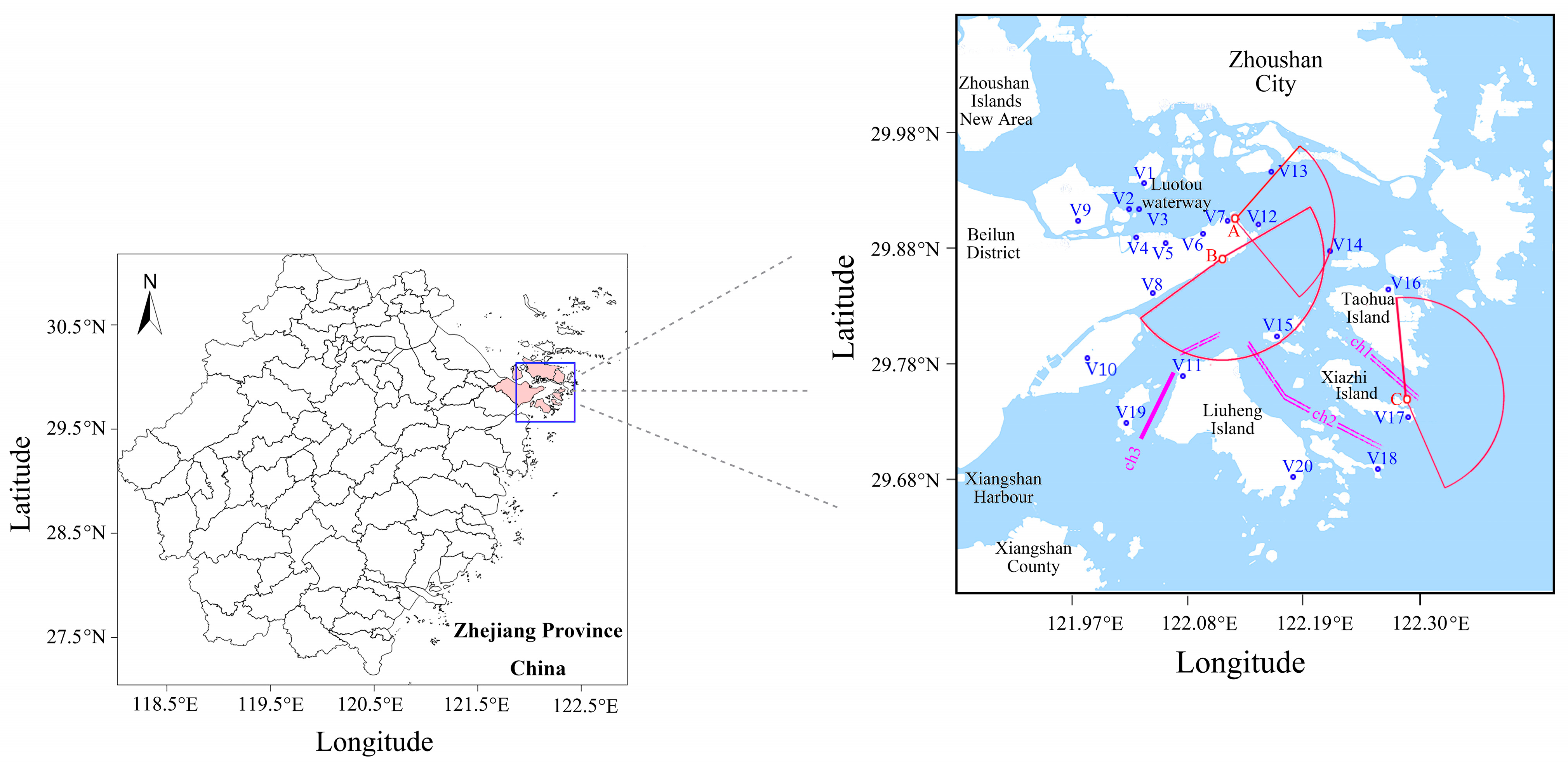
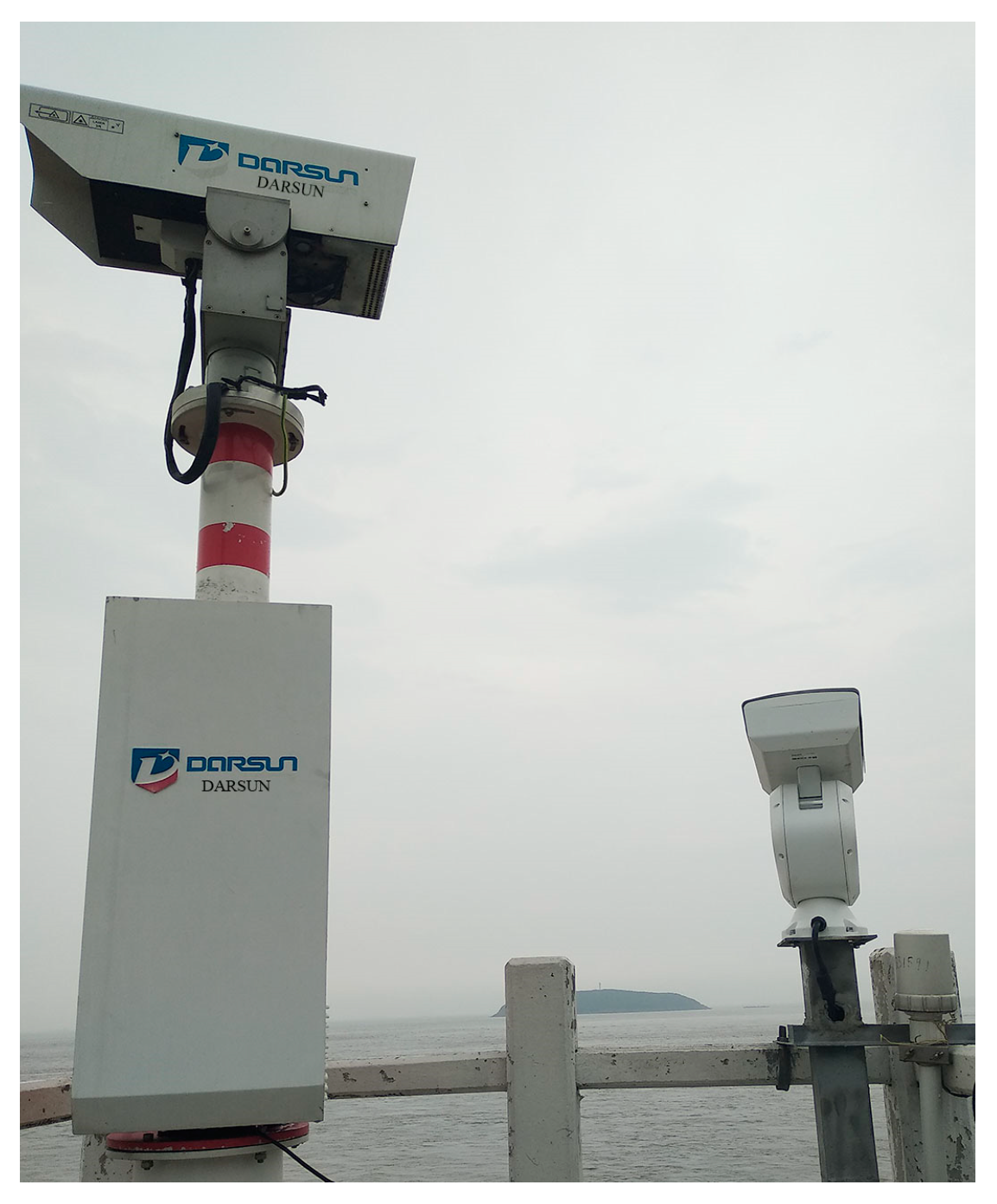
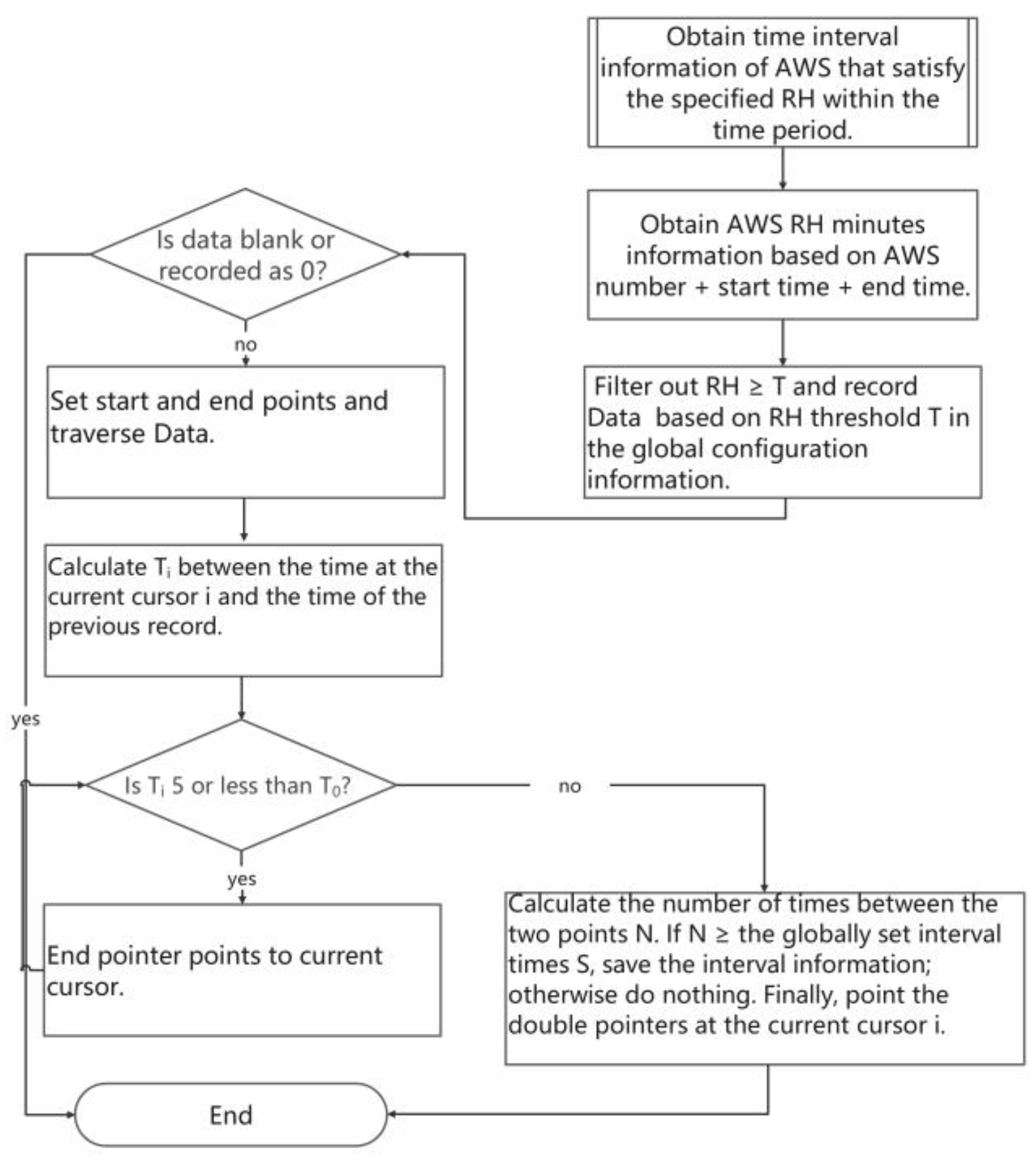
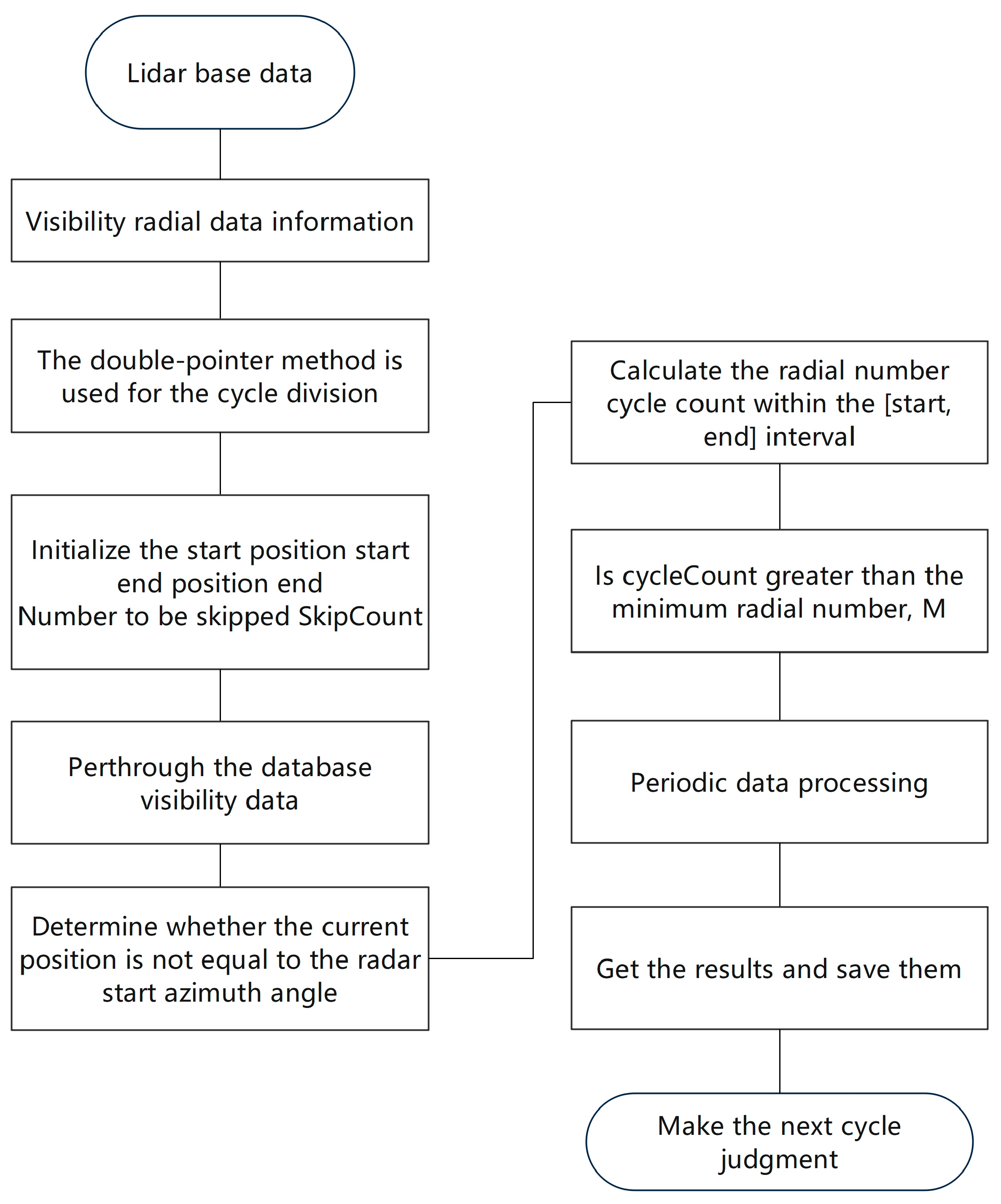
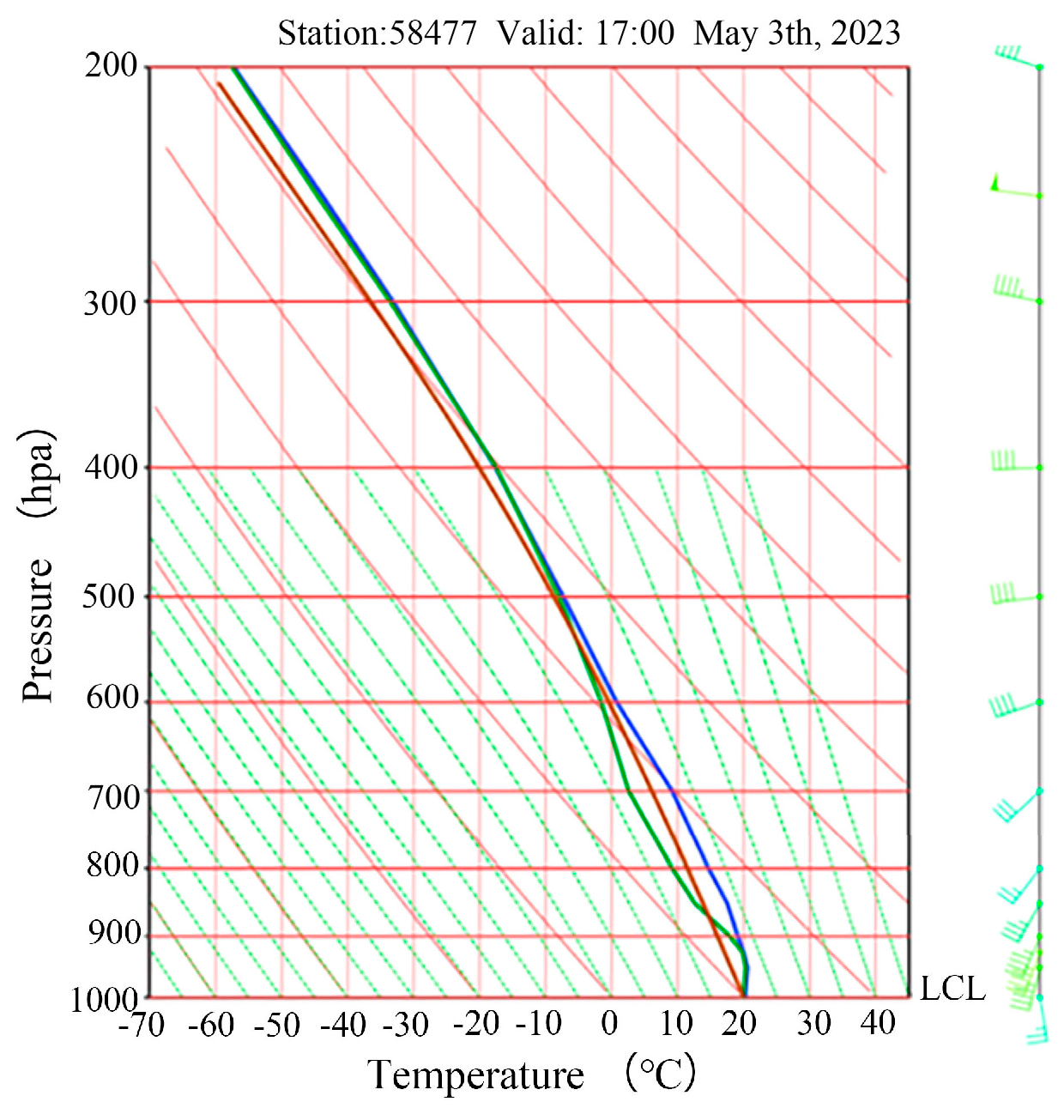
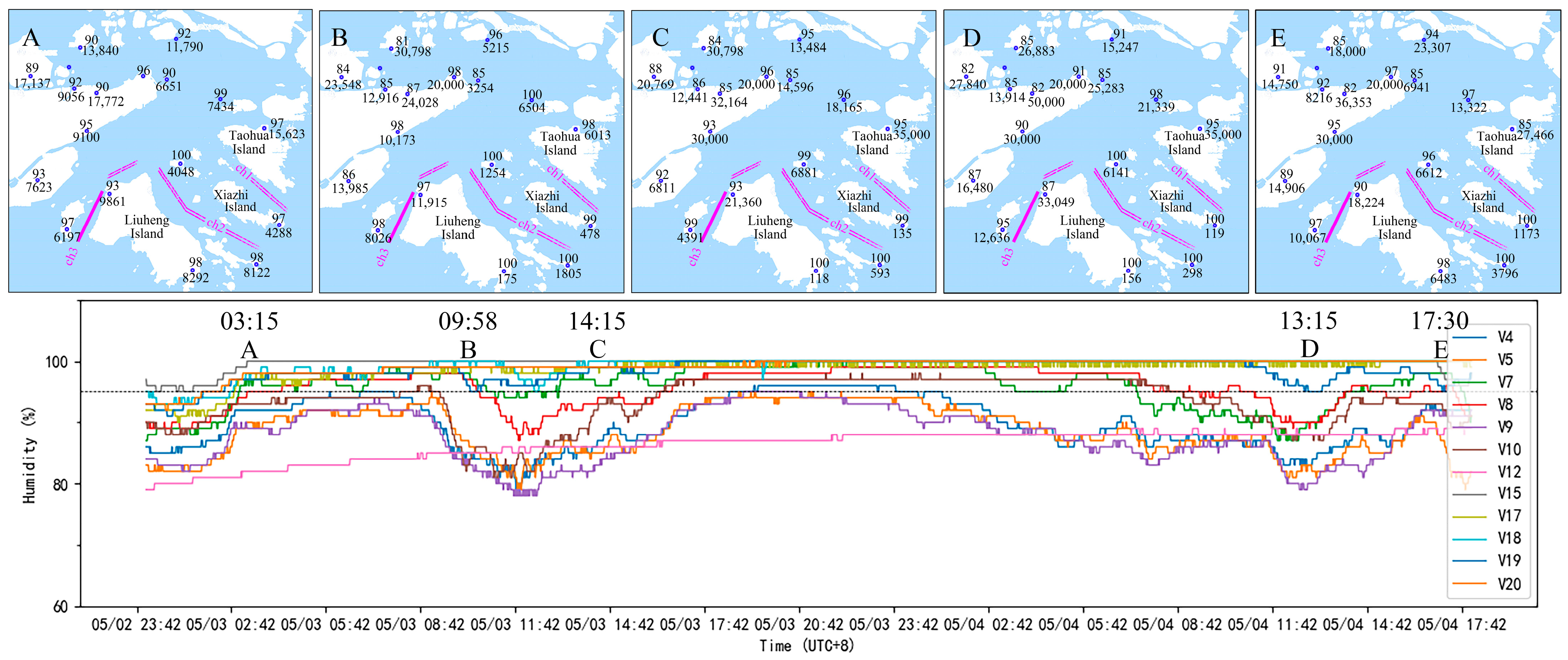

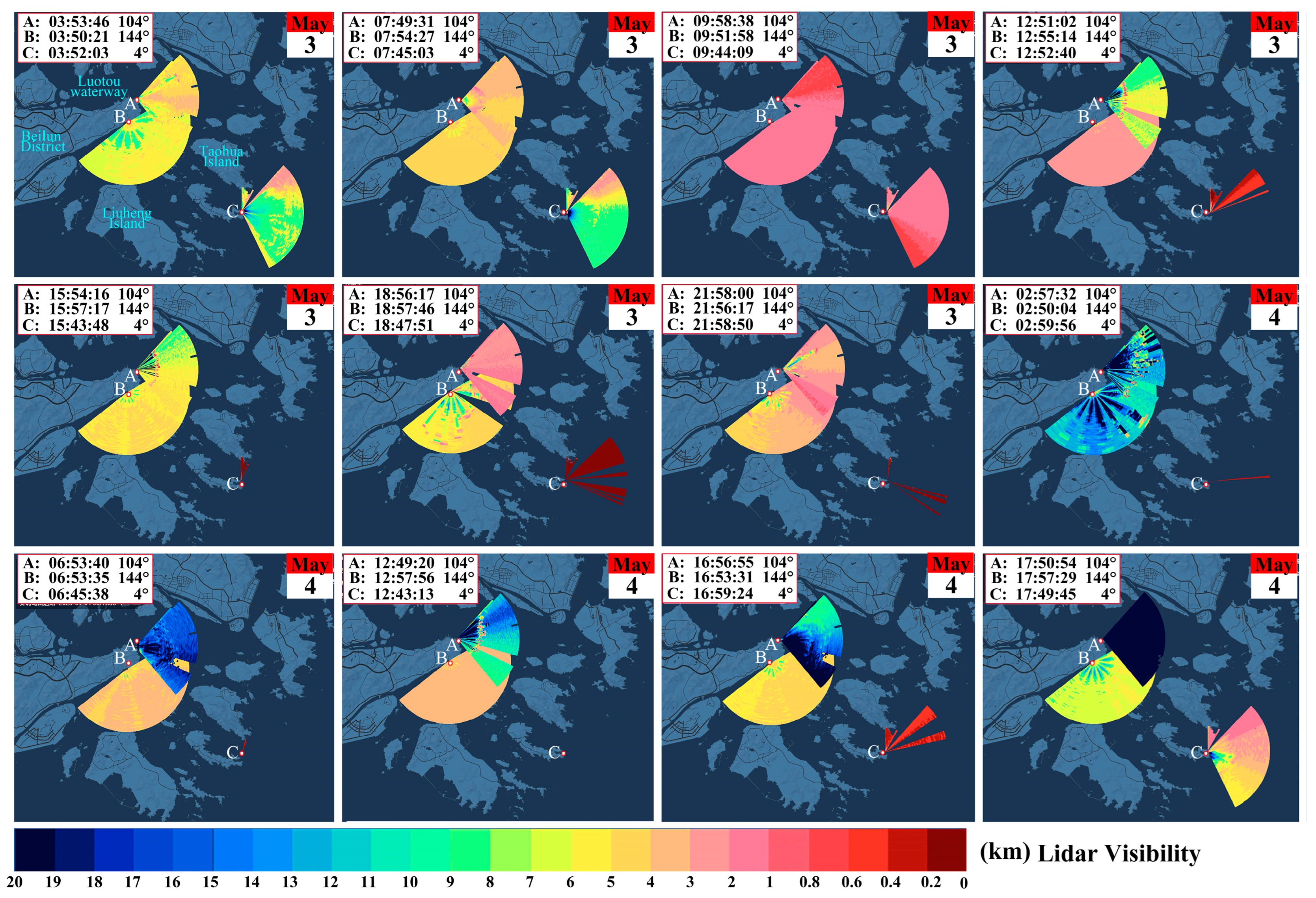
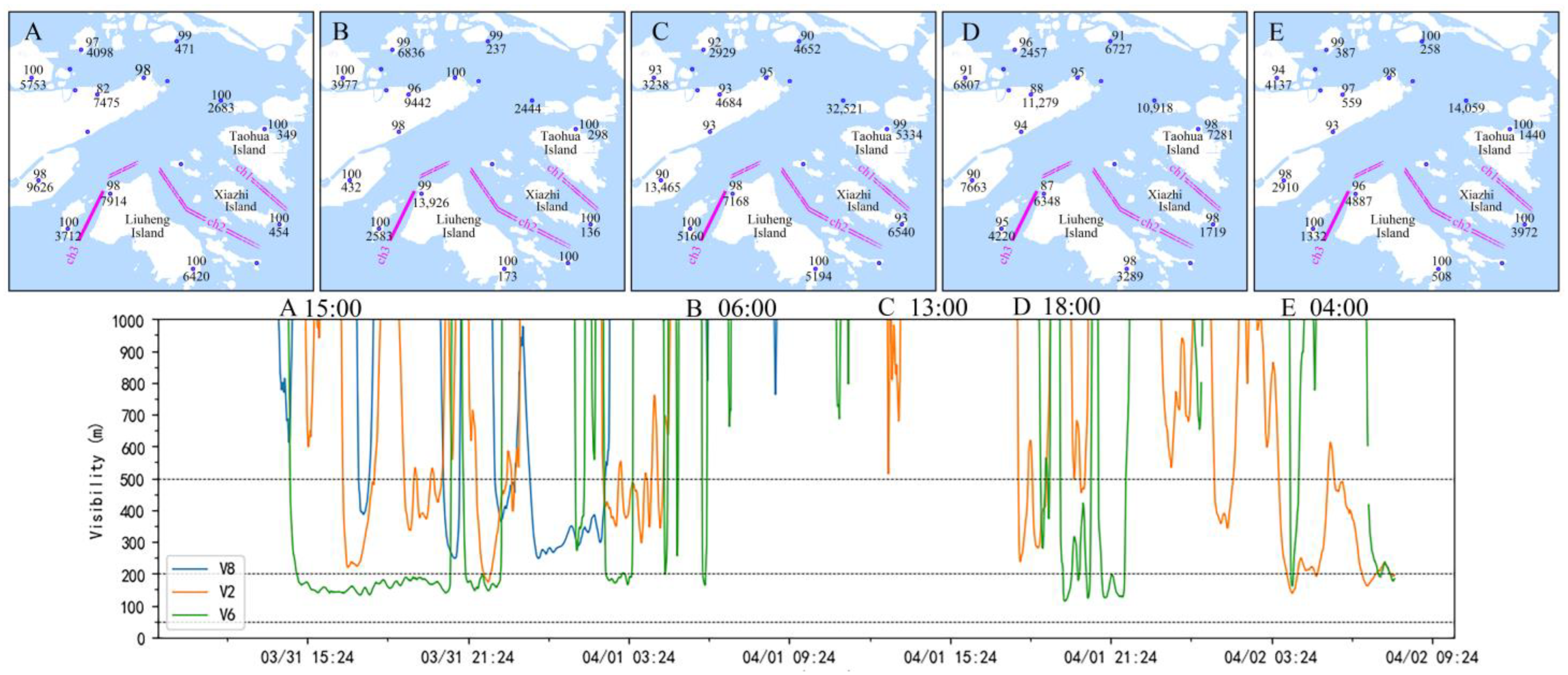
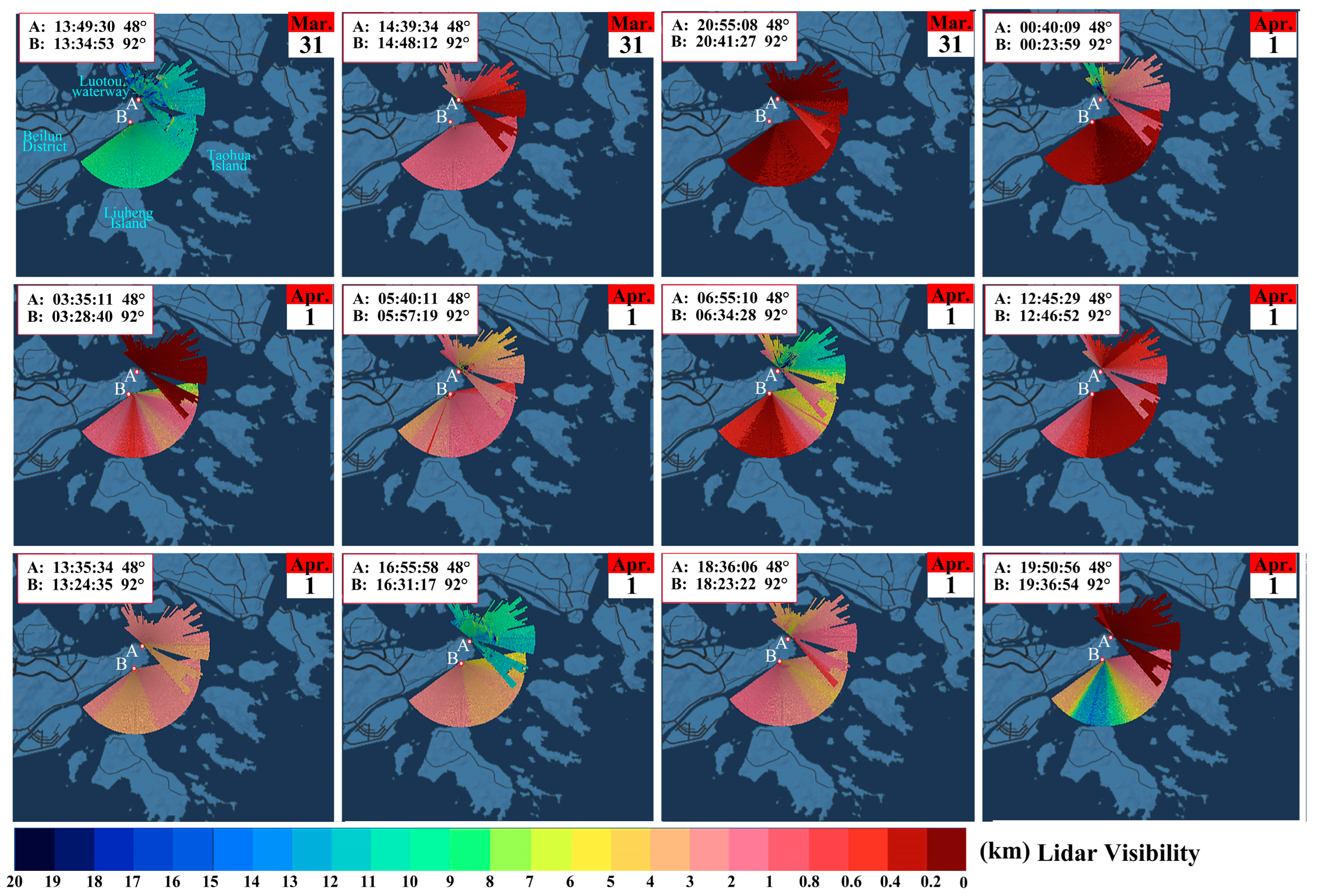
| No. | Code | Station No. | Station Name | Observation Elements |
|---|---|---|---|---|
| 1 | V1 | K2287 | Big Cat Island | V |
| 2 | V2 | K2293 | Cool Hat Mountain | V |
| 3 | V3 | K2295 | White Goose Mountain Reef | V |
| 4 | V4 | K2394 | Bai Feng Primary School | V, RH |
| 5 | V5 | K2321 | Far East wharf | V, RH |
| 6 | V6 | K2288 | Qianhe Environmental Protection Technology Co., Ltd. (Guangdong, China) | V |
| 7 | V7 | K2289 | Zhitou | V, RH |
| 8 | V8 | 10012 | Southgate Village | V, RH |
| 9 | V9 | K2102 | Great Pavilion South | V, RH |
| 10 | V10 | K2328 | Yangjia Mountain | V, RH |
| 11 | V11 | K9717 | Sha Ao | V |
| 12 | V12 | K2381 | Yang Cat | V, RH |
| 13 | V13 | K9626 | Aoshan Wanxiang | V |
| 14 | V14 | K9729 | Dengshan | V |
| 15 | V15 | K9617 | Hu Ni | V, RH |
| 16 | V16 | K9722 | Peach Blossom Wharf | V |
| 17 | V17 | K9515 | Shrimp Zhi | V, RH |
| 18 | V18 | K9804 | Six Heng Small Tsui | V, RH |
| 19 | V19 | K9520 | Buddha Du | V, RH |
| 20 | V20 | K9812 | Ta Tian’ao Village | V, RH |
| No. | Code | Laser Source | Single Pulse Energy | Spatial Resolution | Time Resolution | Pulse Width | Scan Angle | Scan Time |
|---|---|---|---|---|---|---|---|---|
| 1 | A | 1064 nm | 200 μJ | 15 m | 13 s | <10 ns | 310–140° 42–140° (now) | 20 min 10 min |
| 2 | B | 532 nm | 100 μJ | 15 m | 13 s | <10 ns | 60–232° | 10 min |
| 3 | C | 1064 nm | 200 μJ | 15 m | 10 s | <10 ns | 292–148° | 20 min |
| No. | Visibility Extent | WMO | China | IMD | NZP |
|---|---|---|---|---|---|
| 1 | < 10,000 m | Mist | Mist | Null | Null |
| 2 | < 2000 m | Mist | Mist | Null | Mist |
| 3 | < 1000 m | Fog | Fog | Light | Fog |
| 4 | < 500 m | Heavy | Dense | Moderate | Dense |
| 5 | < 200 m | Heavy | Heavy | Thick | Heavy |
| 5 | < 100 m | Extra heavy | Heavy | Thick | Heavy |
| 6 | < 50 m | Extra heavy | Extra heavy | Very thick | Extra heavy |
| No. | Visibility Extent | Fog Level | Impact on Maritime Traffic | Monitoring Gap | Situation Warnings Issued |
|---|---|---|---|---|---|
| 1 | ≥ 4000 m | Mist | No obvious impact | 1 h | No |
| 2 | < 4000 m | Mist | Minor | 30 min | No |
| 3 | < 2000 m | Mist | Moderate | 15 min | Every 15 min |
| 4 | < 1000 m | Fog | Notable | 10 min | Immediately |
| 5 | < 500 m | Dense | Major | 5 min | Intensively |
Disclaimer/Publisher’s Note: The statements, opinions and data contained in all publications are solely those of the individual author(s) and contributor(s) and not of MDPI and/or the editor(s). MDPI and/or the editor(s) disclaim responsibility for any injury to people or property resulting from any ideas, methods, instructions or products referred to in the content. |
© 2023 by the authors. Licensee MDPI, Basel, Switzerland. This article is an open access article distributed under the terms and conditions of the Creative Commons Attribution (CC BY) license (https://creativecommons.org/licenses/by/4.0/).
Share and Cite
Hu, L.; Xu, R.; Yang, M.; Yang, H.; Lu, Y.; Li, C.; Xian, J.; Yao, R.; Chen, W. Enhancing Maritime Safety and Efficiency: A Comprehensive Sea Fog Monitoring System for Ningbo Zhoushan Port. Atmosphere 2023, 14, 1513. https://doi.org/10.3390/atmos14101513
Hu L, Xu R, Yang M, Yang H, Lu Y, Li C, Xian J, Yao R, Chen W. Enhancing Maritime Safety and Efficiency: A Comprehensive Sea Fog Monitoring System for Ningbo Zhoushan Port. Atmosphere. 2023; 14(10):1513. https://doi.org/10.3390/atmos14101513
Chicago/Turabian StyleHu, Lijun, Rong Xu, Ming Yang, Hao Yang, Yun Lu, Chenru Li, Jinhong Xian, Risheng Yao, and Weixuan Chen. 2023. "Enhancing Maritime Safety and Efficiency: A Comprehensive Sea Fog Monitoring System for Ningbo Zhoushan Port" Atmosphere 14, no. 10: 1513. https://doi.org/10.3390/atmos14101513
APA StyleHu, L., Xu, R., Yang, M., Yang, H., Lu, Y., Li, C., Xian, J., Yao, R., & Chen, W. (2023). Enhancing Maritime Safety and Efficiency: A Comprehensive Sea Fog Monitoring System for Ningbo Zhoushan Port. Atmosphere, 14(10), 1513. https://doi.org/10.3390/atmos14101513







